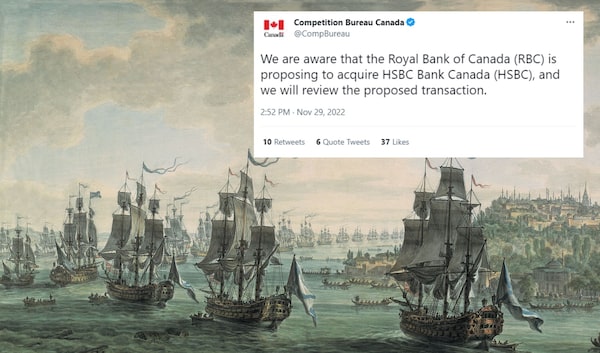
A tweet to launch a thousand ships: The Competition Bureau's tweet that it was looking into the RBC-HSBC banking merger is the latest signal of a newer, scrappier agency.The Globe and Mail
Vass Bednar is the founder of Regs to Riches and the executive director of McMaster University’s master of public policy in digital society program. Jennifer Quaid is a law professor at the University of Ottawa. They are senior fellows at the Centre for International Governance Innovation.
A simple, responsive tweet from the Competition Bureau last week, indicating that it will be reviewing the proposed transaction between the Royal Bank of Canada RY-T and HSBC Bank Canada, signals a brave new voice for our economic regulator. Sometimes, an informal 142-character tweet can be serious business.
The Competition Act requires that all bureau inquiries be done in private. That doesn’t bar the bureau from simply announcing a review for a publicly known deal, as in the current case. But there has long been a predilection at the bureau for being buttoned-up and discreet during merger reviews or market studies.
A casual tweet that challenges the norm of restraint is much more akin to that of the U.S. Federal Trade Commission (FTC), whose Twitter account has almost 100,000 followers. The FTC often offers same-day social-media comments on merger announcements and other competition matters in the news, whereas the norm to date in Canada has been to refrain from comment.
RBC deal for HSBC Canada faces high regulatory, political hurdles
However, while caution is appropriate – for example, where the bureau’s statements might reveal confidential sources – this does not condemn it to silence at all costs. And as Canadians pay more attention to competition trends and issues, the bureau’s tweet could be a sign it recognizes that, as the face of competition enforcement, it needs to be visible and proactive on matters in the public domain.
The tweet is a reminder that the bureau has a voice, as a law enforcement agency, that is distinct from the ministry and minister under which it sits.
We are aware that the Royal Bank of Canada (RBC) is proposing to acquire HSBC Bank Canada (HSBC), and we will review the proposed transaction.
— Competition Bureau Canada (@CompBureau) November 29, 2022
Perhaps we should have seen the tweet coming. Despite that structural limitation, the bureau has been provocative in subtle, wonky ways, most recently through their fascinating response in February to the consultation led by then-senator Howard I. Wetston on Examining the Canadian Competition Act in the Digital Era. It was a refreshingly blunt criticism of long-standing legal and procedural obstacles that have hampered the bureau’s enforcement efforts, and a blueprint for reform that consolidated its best policy ideas based on its perspective as an enforcer.
In its conclusion, the bureau did not mince words: “Canada cannot be complacent … inaction will harm the economy in the long term. Canada needs more competition now.” The message struck a new confident tone that put the world on notice about the bureau’s commitment to serious reform, while also being honest about the current limitations that hinder its ability to take cases.
That public-facing artifact is especially significant because it places the bureau’s ideas on the record, and it essentially signals their preferences for regulatory reform in a way that manages to be both formal and cheeky at the same time.
And given that a separate public consultation on the Future of Competition in Canada launched recently, it is notable that the bureau has already declared what is essentially their agenda for reform ahead of their colleagues from the ministry. Instead of keeping their cards completely close to their chest, the bureau is showing a few every now and then while remaining committed to dialogue and debate.
The bureau’s communications approach has created confusion in the past, such as when Canadian firm Dye & Durham was facing regulatory scrutiny in Australia and Britain earlier this year; at home, we still have no idea whether the bureau is looking into the matter. When the bureau has broken with its norm of silence, such as when they put a call out to market participants in 2020 during a still-ongoing investigation into Amazon, they were criticized by insiders for revealing that work was under way – even though such work is clearly aligned with the priorities of regulators globally.
Signals from the current Commissioner of Competition suggest an emphasis on consumer choice and prices has contoured the review of the Rogers-Shaw merger, which in another economic climate might have been a snooze that sailed through on the efficiency defence. Instead, public scrutiny and frustration have kept a spotlight on the case, making space for this more muscular, articulate bureau in the process.
As the bureau considers significant mergers in the banking and telecommunications space – two cornerstones of Canada’s most familiar oligopolies – we should hope for more of what it has been offering recently: restrained, neutral and factual updates on research and activity undertaken by Canada’s competition authority to keep people up-to-date on policy progress.
Thus far, it seems like the bureau has interpreted its duty to conduct investigations in private somewhat broadly. It has implicitly imposed a culture of secrecy that obscures the actions, interests and activities required to protect and promote competition for the benefit of Canadians at a time when scrutiny should be expected. A simple tweet suggests a change in tone – a casual flash of boldness that citizens seem ready to click on.